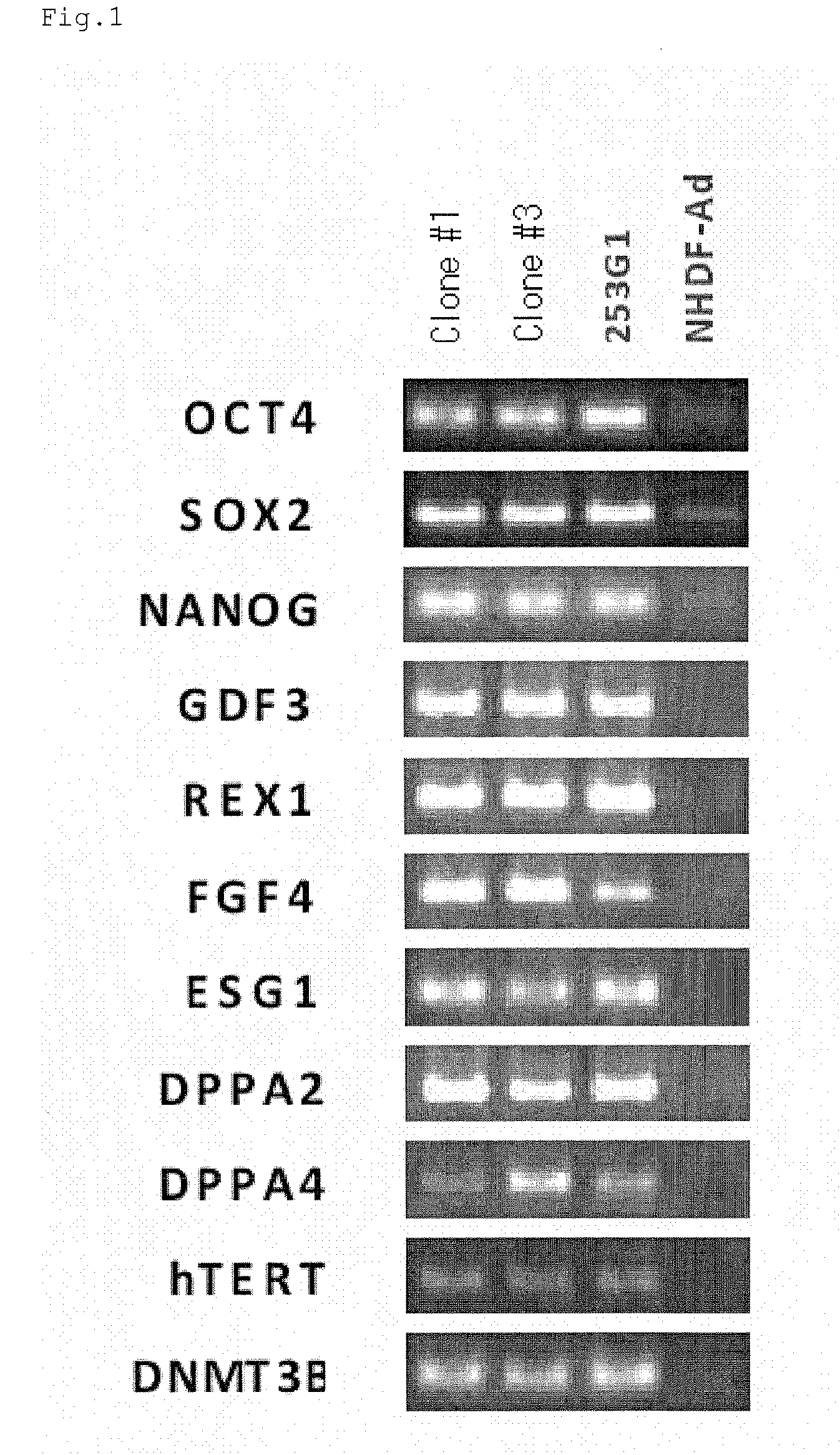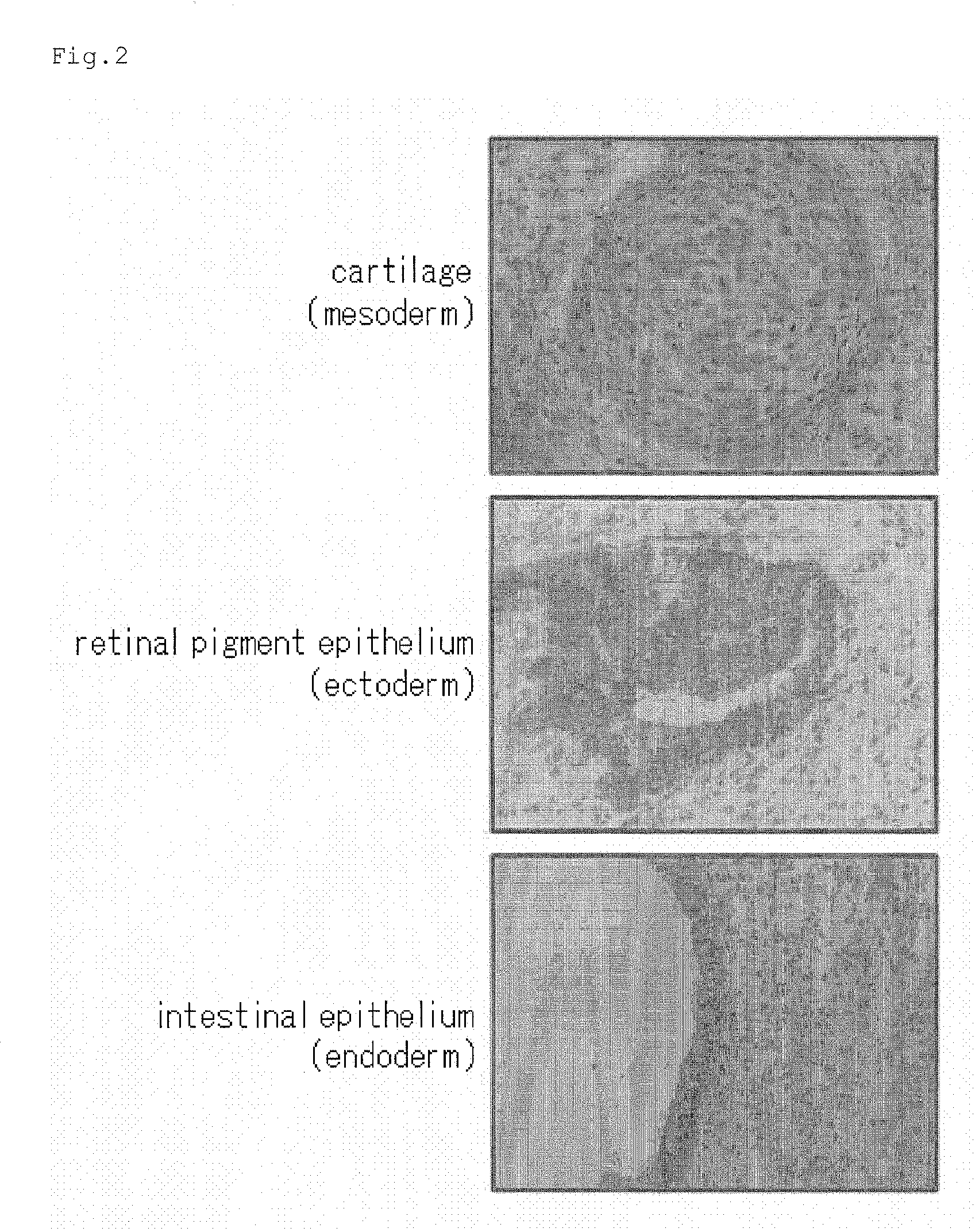Method for production of pluripotent stem cell
a technology of stem cells and cells, applied in the field of production of pluripotent stem cells, can solve the problems of unavoidable risk of cancer of gene-introduced cells, restricted study, etc., and achieve the effect of high engraftment ability
- Summary
- Abstract
- Description
- Claims
- Application Information
AI Technical Summary
Benefits of technology
Problems solved by technology
Method used
Image
Examples
preparation example 1
Cloning of Nuclear Reprogramming Factor Genes
[0058](1) Construction of pDON-AI-2-Neo-SOX2 and pDON-AI-2-Neo-KLF4 Plasmids
[0059]From the sequence information of NCBI database Accession No. NM—03106.2, synthetic primers hSOX2-F and hSOX2-R for amplifying a SOX2 gene having a nucleotide sequence described in SEQ ID No.: 1 or 2 were synthesized, respectively. In addition, from sequence information of NCBI database Accession No. NM—004235.3, synthetic primers hKLF4-F and hKLF4-R for amplifying a KLF4 gene having a nucleotide sequence described in SEQ ID No.: 3 or 4 were synthesized, respectively.
[0060]PCR was carried out with each of a primer pair of hSOX2-F and hSOX2-R, and a primer pair of hKLF4-F and hKLF-R, and PrimeSTAR (registered trademark) MAX PreMix (manufactured by TAKARA BIO INC.), and employing a cDNA synthesized with HumanBrainPolyA+RNA (manufactured by Clonetech) as a template. After completion of the reaction, the reaction solution was subjected to 1.0% agarose gel electro...
preparation example 2
Preparation of a Retrovirus Vector
[0064](1) Transfer into pDON-AI-2 and pDON-5 Plasmid Vectors
[0065]PDON-AI-2-Neo-OCT4, pDON-AI-2-Neo-SOX2, pDON-AI-2-Neo-KLF4, pDON-AI-2-Neo-LIN28, and pDON-AI-2-Neo-NANOG prepared by Preparation Example 1 were treated with a restriction enzyme NotI and SalI, respectively, and fragments generated by subjecting to 1.0% agarose electrophoresis were separated on a gel. Fragments containing open reading frames encoding respective polypeptides were extracted and purified from a gel, each of the fragments was mixed with pDON-5 DNA (manufactured by TAKARA BIO INC.) which had been similarly digested with NotI-SalI, and ligated using DNA Ligation Kit (manufactured by TAKARA BIO INC.). From thus made recombinant plasmids, plasmids in which each gene was correctly inserted were selected, and they were named pDON-5-OCT4, pDON-5-SOX2, pDON-5-KLF4, pDON-5-LIN28, and pDON-5-NANOG, respectively.
[0066]Regarding three genes of OCT4, KLF4 and LIN28, recombinant plasmi...
preparation example 3
Preparation of a Fluorescent Protein-Expressing Retrovirus Vector
(1) Preparation of a Plasmid Vector
[0073]The AcGFP1 gene was transferred from pAcGFP1 (manufactured by Clonetech) into pDON-AI-DNA (manufactured by TAKARA BIO INC.) to prepare pDON-AI-AcGFP1. Similarly, the mStrawberry gene was transferred from pmStrawberry Vector (manufactured by Clonetech) into pDON-AI-2 Neo DNA to prepare pDON-AI-2-Neo-mStrawberry.
(2) Production of a Retrovirus Vector
[0074]According to the same manner as that of Preparation Example 2-(5), a retrovirus vector DON-am-AcGFP1 was prepared from pDON-AI-AcGFP1, and a retrovirus vector DONAI2-am-mStrawberry was prepared from pDON-AI-2-Neo-mStrawberry.
PUM
| Property | Measurement | Unit |
|---|---|---|
| time | aaaaa | aaaaa |
| time | aaaaa | aaaaa |
| humidity | aaaaa | aaaaa |
Abstract
Description
Claims
Application Information
 Login to View More
Login to View More - R&D
- Intellectual Property
- Life Sciences
- Materials
- Tech Scout
- Unparalleled Data Quality
- Higher Quality Content
- 60% Fewer Hallucinations
Browse by: Latest US Patents, China's latest patents, Technical Efficacy Thesaurus, Application Domain, Technology Topic, Popular Technical Reports.
© 2025 PatSnap. All rights reserved.Legal|Privacy policy|Modern Slavery Act Transparency Statement|Sitemap|About US| Contact US: help@patsnap.com



